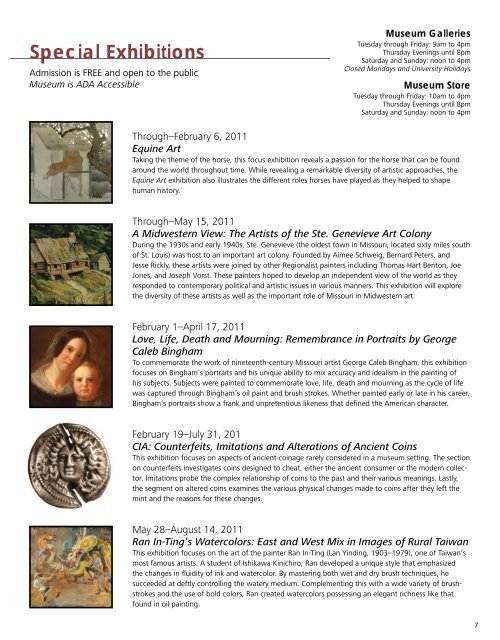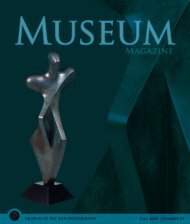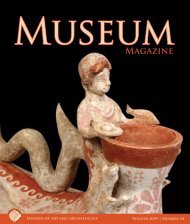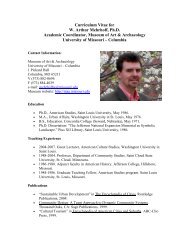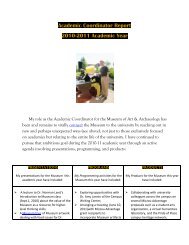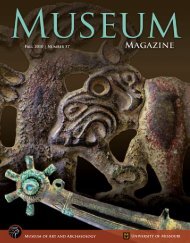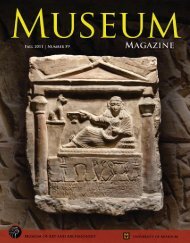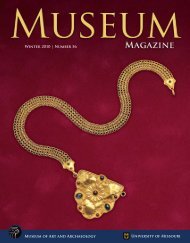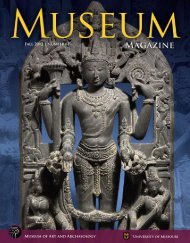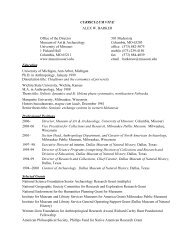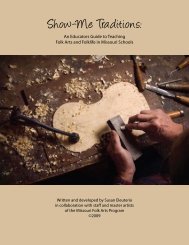CIA: Counterfeits, Imitations <strong>and</strong>Alterations <strong>of</strong> Ancient CoinsKenyon ReedCollections SpecialistEvery object in the museum tells astory, <strong>and</strong> this is especially true <strong>of</strong>coins. Most <strong>of</strong> the coins on permanentdisplay in the <strong>Museum</strong> tell a similar story,one that is short, sweet, <strong>and</strong> relativelysimple: they were struck at a mint, passedthrough a relatively small number <strong>of</strong> h<strong>and</strong>s,<strong>and</strong> then were lost or hidden away untilthey came to be on display in the <strong>Museum</strong>.Their stories are <strong>of</strong>ten <strong>of</strong> luxury <strong>and</strong> privilege,beauty <strong>and</strong> grace, refinement <strong>and</strong> class. But thecoins in this exhibition tell a different story. Their storiesare <strong>of</strong>ten longer, more convoluted, <strong>and</strong> complex, <strong>and</strong> are <strong>of</strong>tenfull <strong>of</strong> trickery <strong>and</strong> deceit, envy <strong>and</strong> imitation, violence <strong>and</strong> pain.The exhibition CIA: Counterfeits, Imitations <strong>and</strong> Alterations<strong>of</strong> Ancient Coins examines these coins in greater depth in anattempt to better tell their stories.Counterfeit coins tell the story <strong>of</strong> trickery, deceit, <strong>and</strong> greed.Counterfeits have been around as long as coins, <strong>and</strong> counterfeitbullion was one <strong>of</strong> the reasons coinage was invented. Ancientcounterfeits were designed to cheat the ancient consumer.Fouree coins, with a base metal core encased in either silveror gold, could circulate for years until their true worth wasdiscovered, while mold cast coins were mixed into bagscontaining <strong>of</strong>ficial currency, <strong>and</strong> probably went unnoticed by thegeneral population (Fig. 2). With the renewed interest in antiquitythat occurred during the Renaissance came a renewed interestin counterfeiting ancient coins, this time to cheat collectors, anactivity that, unfortunately, continues to this day.Imitations tell the stories <strong>of</strong> desperation, impersonation,<strong>and</strong> hope. Coins were imitated for a number <strong>of</strong> reasons. Somecoins were imitated because <strong>of</strong> their popularity <strong>and</strong> respectin international trade, a respect the issuers hoped to gainby copying these revered types. Others were imitated out <strong>of</strong>desperation, in order to provide coins in regions where theywere lacking. Some imitations tell the story <strong>of</strong> cultural influence,others the story <strong>of</strong> cultural or political changes, <strong>and</strong> still others<strong>of</strong> a yearning for the good old days. Imitations <strong>of</strong> ancient coinsFebruary 19 – July 31, <strong>2011</strong>made during the Renaissance speak both<strong>of</strong> helping collectors fill gaps in theircollections <strong>and</strong> <strong>of</strong> the maker’s ideasabout coins that should have existed inantiquity, but didn’t.Alterations tell the story <strong>of</strong> violence<strong>and</strong> pain inflicted by a wide variety <strong>of</strong>physical changes made to coins afterthey left the mint. Some alterations werepractical, such as test cuts to determine thepurity <strong>of</strong> the metal (Fig. 1); halving a coin toprovide much needed small change; countermarking torevalue or confirm the coin’s legitimacy; <strong>and</strong> overstriking, whichwas used to recycle worn coins, to revalue earlier issues, <strong>and</strong>to reinforce imperial authority (Fig. 4). Not all alterations wereutilitarian in nature; some were aesthetic. Large bronze coinswere sometimes hammered around the edge to create protocontorniates,which were then used as decoration on armor orcontainers, or as pieces for board games. Coins <strong>of</strong> all metals wereturned into pieces <strong>of</strong> jewelry. Bronze <strong>and</strong> silver coins were <strong>of</strong>tenjust pierced through so they could be suspended from a chain,but gold coins <strong>and</strong> medallions were usually provided with at leastan added loop, <strong>and</strong> were sometimes set as the centerpiece forextremely elaborate creations (Fig. 3).All <strong>of</strong> the stories told by the coins in this exhibition are rarelytold in regular displays. Some <strong>of</strong> the stories overlap, some mergetogether, but all help to bring to life the vivid <strong>and</strong> intriguing life<strong>of</strong> ancient coins.Fig. 1. Silver Stater <strong>of</strong> Datames, Greek, minted at Tarsus, ca. 373–368 BCE (69.234),<strong>Museum</strong> purchase <strong>and</strong> partial gift <strong>of</strong> Mrs. Mary Frances Osborne Davis <strong>and</strong> Mrs. SusanAnn Davis Aulgur in memory <strong>of</strong> John H. TownsendFig. 2. Terracotta Mold for Casting a Counterfeit Bronze Nummus <strong>of</strong> Maximinus II,Roman, Near East, ca. 317–320 CE (70.340), <strong>Museum</strong> purchaseFig. 3. Gold Medallion with Imitation Solidus, Byzantine, Palestine, Near Hebron, 5th–6thCentury CE (68.175 C), Chorn Memorial FundFig. 4. Bronze Follis <strong>of</strong> Heraclius, Byzantine, minted at Syracuse, 631 CE (69.880),<strong>Museum</strong> purchase <strong>and</strong> partial gift <strong>of</strong> Mrs. Mary Frances Osborne Davis <strong>and</strong> Mrs. SusanAnn Davis Aulgur in memory <strong>of</strong> John H. TownsendFig. 2 Fig. 3 Fig. 46
Special ExhibitionsAdmission is FREE <strong>and</strong> open to the public<strong>Museum</strong> is ADA Accessible<strong>Museum</strong> GalleriesTuesday through Friday: 9am to 4pmThursday Evenings until 8pmSaturday <strong>and</strong> Sunday: noon to 4pmClosed Mondays <strong>and</strong> <strong>University</strong> Holidays<strong>Museum</strong> StoreTuesday through Friday: 10am to 4pmThursday Evenings until 8pmSaturday <strong>and</strong> Sunday: noon to 4pmThrough–February 6, <strong>2011</strong>Equine <strong>Art</strong>Taking the theme <strong>of</strong> the horse, this focus exhibition reveals a passion for the horse that can be foundaround the world throughout time. While revealing a remarkable diversity <strong>of</strong> artistic approaches, theEquine <strong>Art</strong> exhibition also illustrates the different roles horses have played as they helped to shapehuman history.Through–May 15, <strong>2011</strong>A Midwestern View: The <strong>Art</strong>ists <strong>of</strong> the Ste. Genevieve <strong>Art</strong> ColonyDuring the 1930s <strong>and</strong> early 1940s, Ste. Genevieve (the oldest town in <strong>Missouri</strong>, located sixty miles south<strong>of</strong> St. Louis) was host to an important art colony. Founded by Aimee Schweig, Bernard Peters, <strong>and</strong>Jesse Rickly, these artists were joined by other Regionalist painters including Thomas Hart Benton, JoeJones, <strong>and</strong> Joseph Vorst. These painters hoped to develop an independent view <strong>of</strong> the world as theyresponded to contemporary political <strong>and</strong> artistic issues in various manners. This exhibition will explorethe diversity <strong>of</strong> these artists as well as the important role <strong>of</strong> <strong>Missouri</strong> in Midwestern art.February 1–April 17, <strong>2011</strong>Love, Life, Death <strong>and</strong> Mourning: Remembrance in Portraits by GeorgeCaleb BinghamTo commemorate the work <strong>of</strong> nineteenth-century <strong>Missouri</strong> artist George Caleb Bingham, this exhibitionfocuses on Bingham’s portraits <strong>and</strong> his unique ability to mix accuracy <strong>and</strong> idealism in the painting <strong>of</strong>his subjects. Subjects were painted to commemorate love, life, death <strong>and</strong> mourning as the cycle <strong>of</strong> lifewas captured through Bingham’s oil paint <strong>and</strong> brush strokes. Whether painted early or late in his career,Bingham’s portraits show a frank <strong>and</strong> unpretentious likeness that defined the American character.February 19–July 31, 201CIA: Counterfeits, Imitations <strong>and</strong> Alterations <strong>of</strong> Ancient CoinsThis exhibition focuses on aspects <strong>of</strong> ancient coinage rarely considered in a museum setting. The sectionon counterfeits investigates coins designed to cheat, either the ancient consumer or the modern collector.Imitations probe the complex relationship <strong>of</strong> coins to the past <strong>and</strong> their various meanings. Lastly,the segment on altered coins examines the various physical changes made to coins after they left themint <strong>and</strong> the reasons for these changes.May 28–August 14, <strong>2011</strong>Ran In-Ting’s Watercolors: East <strong>and</strong> West Mix in Images <strong>of</strong> Rural TaiwanThis exhibition focuses on the art <strong>of</strong> the painter Ran In-Ting (Lan Yinding, 1903–1979), one <strong>of</strong> Taiwan’smost famous artists. A student <strong>of</strong> Ishikawa Kinichiro, Ran developed a unique style that emphasizedthe changes in fluidity <strong>of</strong> ink <strong>and</strong> watercolor. By mastering both wet <strong>and</strong> dry brush techniques, hesucceeded at deftly controlling the watery medium. Complementing this with a wide variety <strong>of</strong> brushstrokes<strong>and</strong> the use <strong>of</strong> bold colors, Ran created watercolors possessing an elegant richness like thatfound in oil painting.7


